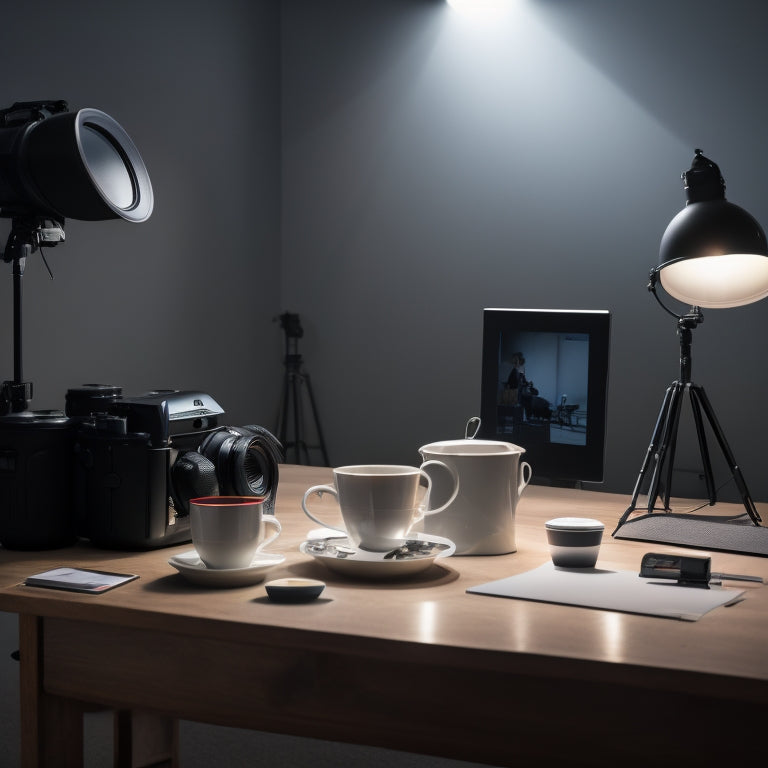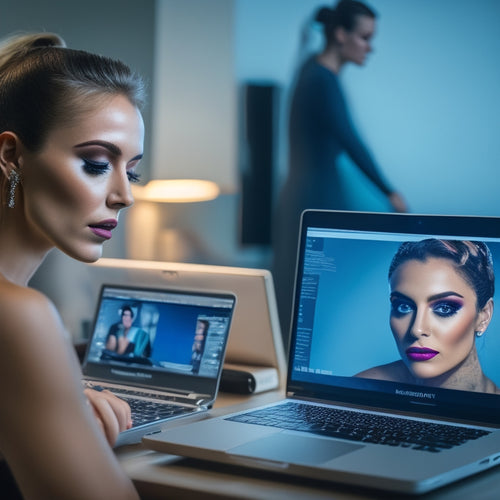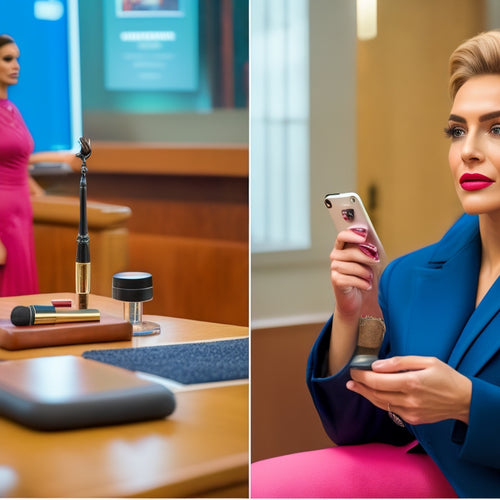
Captivating Video Production for Online Courses
Share
Take, for instance, the online courses offered by LinkedIn Learning, which boast high-quality video production that keeps learners engaged. You, too, can create compelling video content for your online courses by focusing on the visual and audio elements that make a difference. By selecting the right equipment, setting up an ideal studio space, and mastering the art of storytelling, you can create an immersive learning experience that resonates with your audience. But what exactly goes into creating such engaging content, and how can you guarantee your videos stand out in a crowded online learning landscape?
Key Takeaways
• Establish a distinct visual aesthetic for your online course by selecting a color palette that reflects your brand identity and resonates with your target audience.
• Invest in good camera equipment, such as a 4K-resolution camera with a full-frame sensor, and good audio equipment, including a high-quality microphone, to ensure high-quality video production.
• Set up a professional studio space with a tripod, backdrop stand, pop filter, and microphone stand to ensure stability, comfort, and optimal sound quality.
• Master lighting and natural sound techniques by utilizing natural light, capturing morning shadows, and filming in a way that reduces unflattering shadows on faces.
• Edit your video content strategically to keep the audience engaged, varying tempo and tone to create an emotional connection and incorporating pauses for reflection.
Defining Your Visual Aesthetic
As you start creating engaging video content for your online course, establishing a distinct visual aesthetic is vital in capturing your learners' attention and reinforcing your brand identity. This visual identity will set the tone for your course and differentiate it from others.
A well-defined aesthetic will also help create a sense of continuity throughout your course, making it feel more cohesive and professional.
An essential aspect of your visual aesthetic is your color palette. This palette should reflect your brand identity and resonate with your target audience. Choose a palette that's consistent with your brand's personality and messaging.
Consider the emotions and associations that different colors evoke, and select a palette that aligns with your brand's values and tone.
Choosing the Right Equipment
When it comes to choosing the right equipment for your online course videos, you'll want to focus on two essential aspects: camera options and audio quality.
You'll need to decide on a camera that fits your budget and meets your visual aesthetic goals, whether that's a high-end DSLR or a smartphone with impressive video capabilities.
Meanwhile, investing in good audio equipment will make sure that your students can hear you loud and clear, free from distractions and background noise.
Camera Options Matter
You'll be surprised at how much of a difference the right camera can make in capturing high-quality video for your online course. With so many options available, it's important to select a camera that meets your specific needs.
When it comes to brand variety, you'll find a range of options, from Canon and Nikon to Sony and Panasonic. Each brand has its strengths and weaknesses, so it's vital to research and compare features before making a decision.
One important factor to keep in mind is sensor size. A larger sensor size generally produces better image quality, with more detail and depth. A full-frame sensor, for example, can capture stunning footage with a shallow depth of field, making your subject stand out.
On the other hand, a smaller sensor size may compromise on image quality, but can still produce excellent results with the right lighting and settings. By understanding your camera options and choosing the right one for your online course, you'll be well on your way to creating engaging, high-quality video content that resonates with your audience.
Audio Quality Essentials
With your camera in place, it's time to turn your attention to the often-overlooked yet equally important aspect of video production: capturing high-quality audio that complements your visuals and engages your audience.
As you invest in the right equipment, remember that good audio quality isn't just about loudness, but also clarity and depth. You'll want to choose a microphone that can pick up your vocal inflections, capturing the nuances of your tone and pitch.
When selecting a microphone, consider a lavalier or shotgun mic for crisp, focused sound. If you're recording in a noisy environment, look for a mic with noise-cancelling features.
Don't forget to invest in a portable audio recorder as a backup, ensuring you have a safety net in case your camera's audio fails.
Setting Up Your Studio Space
As you prepare to set up your studio space, you'll want to make sure you have all the essential items within arm's reach.
You'll need to create an optimized acoustic environment that minimizes echo and background noise, allowing your students to focus on your instruction.
Studio Essentials Checklist
To transform any room into a professional studio, start by checking off these important items on your studio setup checklist. You'll want to guarantee you have a reliable camera, microphone, and lighting equipment to capture high-quality video and audio. Don't forget a tripod to stabilize your camera and a backdrop stand to create a professional-looking background. A pop filter and microphone stand will also help reduce noise and improve sound quality.
Next, consider the comfort and safety of your talent (that's you, the instructor!). A comfortable chair, a water bottle, and a few snacks can go a long way in making your recording sessions more enjoyable. Good backstage etiquette is key, so make sure you have a 'quiet on set' sign and a place for your talent to relax when not recording.
Optimizing Acoustic Environment
You'll want to carefully design your studio space to minimize echo, reverberation, and external noise, ensuring that your audio recordings sound crisp and professional. A well-planned acoustic environment is essential for producing high-quality video content.
To achieve this, you'll need to implement effective soundproofing strategies. Start by identifying potential noise sources, such as windows, doors, and air vents, and take steps to seal or block them. Additionally, consider adding acoustic panels to your walls and ceiling to absorb sound waves and reduce echo.
Proper room acoustics are also important for capturing clear audio. Position your recording equipment in a way that minimizes sound reflections and echoes. Consider investing in sound-absorbing materials, like acoustic foam or soundproofing blankets, to further reduce reverberation.
By optimizing your studio space, you'll be able to produce audio recordings that are free from distractions and interruptions, allowing your students to focus on the valuable content you're providing.
Mastering Natural Light and Sound
Capture high-quality video by harnessing the power of natural light, which can make a significant difference in the overall production value of your online course. You'll be amazed at how a well-lit setting can enhance the entire production.
When filming outdoors, take advantage of the soft, warm light during the golden hour or overcast days. These conditions will help reduce harsh shadows and create a more appealing, gentle light.
To create an immersive outdoor ambience, consider filming in the morning when the sun is still low. The morning shadows will add depth and dimension to your scene, making it feel more engaging and realistic. Additionally, the softer light will help to reduce unflattering shadows on your subject's face.
Working With Camera Angles
Now that you've mastered the art of harnessing natural light, it's time to focus on creating visual interest by experimenting with different camera angles, which can add depth, emotion, and energy to your online course videos.
As you work with camera angles, keep in mind frame composition. A well-balanced frame can guide the viewer's attention and create a sense of harmony. Experiment with different angles, such as a low-angle shot to make your subject appear powerful, or a high-angle shot to convey vulnerability.
When it comes to subject interaction, camera angles can greatly impact the mood and tone of your video. For example, a close-up shot can create a sense of intimacy and connection with the viewer, while a wide shot can provide context and establish the scene.
Don't be afraid to mix and match different angles to keep your video engaging and dynamic. By incorporating a variety of camera angles, you'll be able to create a visually appealing video that captures and holds your viewers' attention.
With practice, you'll develop your own unique style and visual language, making your online course videos truly enthralling.
Captivating Storytelling Techniques
As you craft your online course video, remember that compelling storytelling is key to keeping your audience invested, and that's where techniques like emotional connections, vivid imagery, and unexpected twists come into play. To create an emotional connection with your audience, you need to make them care about the story you're telling. This can be achieved by sharing personal anecdotes, highlighting relatable struggles, or showcasing inspiring achievements.
Here are some storytelling techniques to keep in mind:
| Technique | Description | Example |
|---|---|---|
| Emotional Connection | Create a personal connection with your audience | Share a personal struggle and how you overcame it |
| Vivid Imagery | Use descriptive language to paint a picture | Describe a scenic landscape or a memorable event |
| Unexpected Twist | Add surprise to keep the audience engaged | Reveal a surprising statistic or a game-changing idea |
| Hero's Journey | Take the audience on a transformative journey | Share a story of overcoming obstacles and achieving success |
Editing for Engagement and Flow
When editing your online course video, you'll want to pace your content to keep your audience hooked, making strategic cuts and switches that create a seamless flow. This is where pacing strategies come into play.
By varying the tempo and tone of your video, you can create an emotional connection with your viewers, keeping them engaged and invested in the content. To achieve this, you can use emotional triggers such as music, sound effects, and visuals to evoke emotions and create a sense of anticipation or excitement.
Effective pacing also involves creating a natural flow between scenes, using shifts that are smooth and logical. This helps to maintain the viewer's attention and prevents distractions. Additionally, consider using pauses or breaks to give viewers a chance to process the information and reflect on what they've learned.
Adding Visual Effects and Transitions
You can enhance the production value of your online course video by incorporating visual effects and effects that improve the learning experience, guide the viewer's attention, and create a polished look.
Visual effects can be as simple as adding motion graphics to highlight key concepts or using dynamic overlays to emphasize important information. These elements can add a professional touch to your video and make it more engaging for your learners.
When adding visual effects, it's crucial to strike a balance between enhancing the learning experience and overwhelming the viewer. Too many effects can be distracting, so use them judiciously to support your message.
For instance, you can use animations to illustrate complex concepts or effects to smoothly move between topics. By incorporating visual effects thoughtfully, you can create an engaging video that keeps learners engaged and motivated.
Finalizing Your Video Output
Now that your video is edited and visually enhanced, it's time to finalize your video output by selecting the best file format, resolution, and compression settings to guarantee seamless playback across various devices and platforms.
You've worked hard to create engaging content, and you want to make sure it looks great on any device.
When finalizing your video output, consider the intended platform and audience. Will your video be streamed online, downloaded, or played on a specific device? This will help you choose the right file format, such as MP4, AVI, or MOV.
Resolution is also important, as it impacts video quality and file size. A higher resolution like 1080p or 4K may be ideal for larger screens, while 720p or 480p might be better suited for mobile devices.
Don't forget about color correction and output formatting. Ensure your video's color palette is consistent and visually appealing.
Frequently Asked Questions
How Do I Ensure Consistency in Video Quality Across All Course Lessons?
To maintain consistency in video quality, you'll want to establish Brand Standards and a strong Visual Identity, outlining tone, style, and aesthetic guidelines to uphold cohesion across all course lessons, guaranteeing a professional and recognizable brand image.
Can I Use a Smartphone as a Substitute for a Professional Camera?
'You can definitely use your smartphone as a substitute for a professional camera, leveraging mobile filmmaking and clever camera hacks to produce high-quality video, but be mindful of lighting and sound quality to guarantee consistency.'
How Long Does It Typically Take to Produce a High-Quality Video Lesson?
"You'll be shocked to know it can take an eternity (okay, maybe 10-20 hours) to produce a high-quality video lesson, depending on your production timeline and content complexity - but trust us, it's worth it!"
What Is the Ideal Video Length for Engaging Online Course Content?
"When creating online content, you'll want to keep videos concise, as attention span is short. Aim for 5-10 minute videos to maximize viewer engagement, ensuring learners stay focused and retain information effectively."
Do I Need to Invest in Expensive Software for Video Editing and Post-Production?
"Back in the Renaissance era, Leonardo da Vinci would've envied your video editing skills! You don't need to break the bank; conduct a cost-benefit analysis and explore free alternatives like Shotcut or Lightworks, which can deliver professional results without the hefty price tag."
Related Posts
-

Top Dance Makeup Tools for Perfect Stage Looks
To create a flawless stage look, you'll need the right tools and techniques. Start with high-quality makeup brushes, ...
-

10 Essential Online Courses for Dance Makeup Artists
You're a dance makeup artist looking to enhance your skills and stand out in the industry? From mastering fundamental...
-

Legal Battle: TikTok's Makeup Looks Ownership Uncertainty
TikTok's rise in popularity has sparked a legal battle over makeup looks ownership, leaving creators vulnerable to ex...


